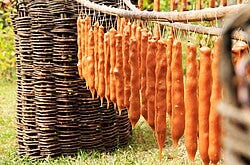


It only takes a trip to another culture to recognise your culinary way of life isn’t necessarily the best. In four days at the Zeg Storytelling Conference in Tbilisi, I don’t think I ate a single item of processed food. That’s not to say that the more than ten branches of McDonalds in the Georgian capital don’t do a roaring trade. But the Georgian way of eating doesn’t involve the long list on food packages we’re so used to in the west that includes a jumble of letters and numbers, preservatives and emulsifiers, because Georgians tend not to eat from packages. They eat from fields and allotments, bushes and fruit trees.
At Zeg, rebel restaurateur Meriko Gubeladze, chef-owner of restaurants Shavi Lomi, Ninia’s Garden and Cafe Leila, debated with fellow chef-owner and similar rebel Tekuna Gachechiladze of the contemporary fine-dining Cafe Littera along with Taqueria Teko’s Tacos and Akura San, their shared mutiny against the USSR’s colonialist efforts that had controlled the menus Georgian restaurants could present. Independently, the two chefs have redefined traditional Georgian cuisine, expanding not contracting its sweep. To a packed room, Tekuna pumped her fist in the air and proclaimed, “ We f*****d Russia with food!”


Things haven’t changed. After their initial soft invasion to avoid being drafted to Ukraine, many Russians are now leaving Tbilisi, made uncomfortable by graffiti everywhere telling them, bluntly, to “go”, and restaurants refusing to serve them.
In the Soviet era, Georgia’s food was the favourite of loyal comrades across the Union. When Russians wanted to celebrate, they headed for Moscow's most popular restaurant, the Aragvi, for its Georgian menu that was a whole world not just a republic away from Russia’s plodding fare.
Georgia’s local farms, predominantly organic, grow some of the world’s most succulent food. Even Persian mini cucumbers don't come close in flavour to those of Georgia, somehow nutty, and sweet, and tight in bite. Georgians rejoice in tomatoes incomparably more sumptuous than those of Italy.
Meanwhile in the industrial world, Big Food Biz is mulling over how it can develop the sector of the processed food market dubbed, with zero irony, ‘Better-For-You-Snacks’. Thing is, as any Georgian - or Greek or Turk, or Middle Eastern or Spanish or Portuguese individual will tell you, to snack can’t be “better for you”. Unless they’re a fruit or raw vegetable, snacks, being eaten between meals, are not essential fare. They’re treats.
Not so in the west. They’re the edible part of the ubiquitous I-want-it-now-so-I’m-definitely-indulging-myself capitalist culture. Still, the pleasure snacks give may be diminishing and a frisson of consumer discomfort setting in. Consultancy Innova Market Insights has established that one third of buyers globally are increasing their consumption of ‘healthy’ snacks over high-sugar or full-fat, full-salt temptations. They're not giving those up entirely, of course, but if you’re a dedicated snacker, it’s a positive move.
Nestlé, Mondalez and the other Big Brothers of the industrial food complex who manufacture the globe’s bestselling snacks are delighted: by 2033, this ‘healthy snacks’ market will be worth a predicted $53 billion dollars.
Already making inroads, the Better-For-You-Snacks category includes baked fruit crisps. How healthy baked snacks are is in question. When a fruit is submitted to high temperatures, some of its vitamins and minerals will be lost. You’ll still benefit from most of its nutrients and fibre, but why not eat the actual fruit? Along with its other advantages, it’s cheaper and there’s no unnatural packaging to toss out.
As to baked vegetable crisps, they do contain less oil. But they have the same amount or more of salt plus chemical ‘flavourings’ essential to making them taste as seductive as your regular chip.
This manipulation shoves them into the Processed Foods category, about which the public understands very little. Chris van Tulleken reckons, in his bestseller Ultra Processed People, that UPFs (Ultra Processed Foods), deliberately engineered with emulsifiers and modified starches and additives, hack our brains with desires that disrupt our normal appetite regulators.
Understandably, you may well by now have decided to Unsubscribe from so much dispiriting information. Big Food will rub its greedy hands in glee, watching the dollars pour in from consumers who prefer their scrumptious Kettle Chips to disturbing information.
Ignore the depressing facts but do consider the extent of the pleasure of the snack you have been manipulated to crave. If Netflix's latest offering is distracting you, even a Family Size or Sharing Bag of chips is only going to take, what? 30 mindless minutes? to shovel down.
A Georgian ‘supra’, a feast of many and diverse dishes that make it the exceptionally generous Georgian equivalent of a Middle Eastern mezze, takes hour after convivial hour to consume. Long conversations are undertaken, poetry recited, polyphonic songs sung, friendships deepened, and endless toasts made. Until recently, there were even toastmaster training schools teaching the usually male tamadas the toasting rituals.
Can you name a snack that delivers all that? Not even the current ‘small-plates’ fad of the US and the UK can begin to replicate the communal joy (and loosening of restraints with the tamada’s regular interruptions for those heartfelt toasts) of the Georgian supra.
Unlike Georgian wines, evidence of which has been carbon-dated back to (you’ll need a drink for this) 5980 BC, the supra by comparison is relatively recent. The banqueting tradition is thought to have been introduced by the Safavid dynasty which ruled from 1501 to 1722, with a brief resurgence from 1750 to 1773. Under Shah Abbas, who reigned from 1588 to 1629, the immense empire covered eastern Georgia, Persia, Azerbaijan, Armenia, Bahrain, Russia, Iraq, Kuwait, Afghanistan, and parts of Turkey, Syria, Pakistan, Turkmenistan and Uzbekistan. Although there are historical records of the Georgian habit of feasting, its structured form led by a tamada isn’t noted until the 19th century. Nor, in reference to feasting, is the word “supra”, literally ”tablecloth”.
Even inquisitive tourists rarely have Georgia on their bucket lists. That’s partly because thanks to strong family ties, few Georgians who might have introduced us to their culture have moved abroad until recently, and partly because it’s a pain to get to. That is changing. Go there before Big Food Biz’s marketing efforts to promote the west’s unhealthy snacking habits do.
Churchkhela are not calorie free but they are a fully natural sweet snack made from grape juice and the ubiquitous Georgian walnuts. Don’t be put off by this photograph which isn’t mine. They aren’t tricky to pull off, the cooking method not dissimilar to making a béchamel sauce. I’ve done it but, as embarrassingly often, ate them or gave them away before remembering to take a picture. These quantities will create two, so multiply up if you want to introduce more to healthy Georgian snacks.
Cooking string and needle
40 walnut halves
1¾ litres/3 pints white grape juice
150g/¾ cup sugar
120g/1 cup flour in a mixing bowl
icing/confectioners’ sugar for dusting
Tie a doubled length of cooking string or any parcel string between two chairs and lay pages of a newspaper underneath to catch the juice drips.
Add the walnuts to a hot pan and heat on a low-medium heat for 2-3 minutes, taking care not to burn them.
Thread a needle with a 70cm/30in length of cooking string. With the flat side of the nuts facing up, thread up to 20 walnut halves onto the thread, leaving one longer end to grip during the process and for tying later. Cut the thread and knot the ends. Repeat till all the walnuts have been used.
In a large pan over medium heat, combine the juice and sugar, stirring every so often until the sugar melts. Slowly pour the liquid into the flour, stirring briskly to prevent lumps than pour back into a clean pan and cook over medium heat, stirring, until the mixture thickens.
Turn the heat right down but not off, to keep the mixture warm. Dip each walnut thread into the mixture to coat it entirely then suspend onto the string between the chairs with a butterfly knot you can untie to repeat the process after 15-20 minutes when the strand is still tacky but no longer dripping. Repeat 10 times till you have a fat fruit sausage. Leave the churchkhela hanging until they are no longer sticky to the touch, 3-4 days, then roll in icing or confectioners’ sugar.






